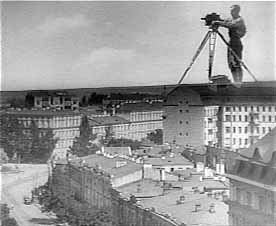
The camera looks over the city
in Man With a Movie Camera.
As explained above, Man With a Movie Camera continuously refers to its own machinations and includes depictions of the transit lines and assembly lines that were building the new state. In his own way, Berkeley deferred to the majesty of the machine through song and dance. Throughout the film we watch hundreds of tap-panted flappers endure grueling rehearsals. As they hop and stomp we hear a fast piano and the rhythmic, methodical sound of hundreds of feet stamping out the same patterns with a force that sounds like the chugging of a train or the firing of rounds from a shotgun. Later, the sound of leaping ladies becomes the soundtrack for a montage of kaleidoscopic images.
These images, of women uniformly kicking their legs and bowing their heads, move clockwise and counter clockwise against one another like the ratchets and sprockets of a finely tuned machine. This pattern is repeated in an overhead shot of the identical dancers forming two circles that move in the opposite direction from one another. "Side by side they’re glorified" in one of the most erotic depictions of the gears that make a clock tick.
The finale of the title-song dance number from 42nd Street involves dancers ascending a set of stairs carrying cards. When they’re correctly positioned, the women turn the cards around to reveal a reproduction of New York’s skyline. The women part and give way to the view, from the bottom, of an enormous skyscraper. Busby Berkeley was as concerned with machines as he was with the women who moved in their likeness.
In Man With a Movie Camera, Vertov shoots his own film as it is being played in a theater. Similarly, Berkeley’s film is self-referential. At the beginning of 42nd Street, New York socialites learn that the musical’s producer, Julian Marsh, is "putting on a show." The movie depicts jeweled women and tuxedoed men as typical of a musical audience, and the wealth of the Broadway crowd is pitted against the working-class throngs who fill the rows of cinema seats. In Berkeley’s two audiences, the importance of cinema is revealed. Movies made spectacle available to everyone and provided their audience with the experiences that were also afforded by new methods of transportation. Both filmmakers used their films to sympathetically depict the audience they were trying to attract.
For the politically conscious Vertov, movies educated the masses cheaply and advertised the hope he had invested in the new state. Vertov knew that movies could encourage unity more than any other art form and believed he could bring people together in a shared love for their country and its propulsion through the twentieth century, by the pistons and pulleys of progress. Arguably, Berkeley’s purpose was not as lofty, but the filmmakers’ work shared a tone of celebration. The audiences who saw 42nd Street were witness to the thrills of life on the stage, in its wings and on the streets of New York City. 42nd Street was not a call to arms, but it did raise a cheer for the most important city of the time. American filmgoers were not necessarily unified in their love for their nation but, instead, the American dream was thinly disguised as the story of a working-class hoofer who made it big. Audiences were only asked to leave reality outside at the ticket booth, while Vertov insisted that his audiences learn to love the real mother Russia as he knew it could be. Both movies were dusted with the sugar of hope in a tumultuous period of fear and change.
In the netherworlds of politics and art a message must appeal to a wide variety of people for it to be received and shared. In the early years of the twentieth century a dynamic political climate scented the air. Dziga Vertov inhaled the aromas of pungent sweat while Busby Berkeley preferred a pouff of French perfume. Berkeley’s masturbatory mechanics lured audiences into theaters and in a dimly lit cinema delightful dames built monuments to the gear, the train and the zipper. Vertov gauged the level of national pride and tried to hasten its momentum with the igniting engine of purpose. In both cases, they recognized that a new society, or a popular production, would require the talents of every nubile young dreamer or soldier of hope.
Both filmmakers were working at a time when societies believed they could perpetuate themselves with the uninterrupted hum of an assembly line. Cubism made people see the shapes and colors of the world with new eyes and the filtered visions of both men identified with that view. Every new building, appliance and gimmicky gadget brought a sense of ease. Inventors and manufacturers created new objects and methods because these were the stuff of dreams. As every fashionable upstart zipped the fly of their pants they knew that this was not their parents’ world. Instead, the world would be re-constructed in proletarian fashion with the spit and shine of a tap shoe.
page 3 of 3
 
Go to bibliography.
Nicole Armour currently resides is San Francisco. She is a tap dance
enthusiast with a penchant for modern art, and she can be reached at
tallulah@sirius.com.
|



